| Columns Retired Columns & Blogs |
So, for >100x more than the AkitikA GT-102, you are getting similar to worse performance?
I measured the Verity Monsalvat Amp-60 using my Audio Precision SYS2722 system (see the January 2008 "As We See It"). The Amp-60 has no heatsinks per se; instead, its massive aluminum chassis dissipates heat. Before I test an amplifier, I precondition it with both channels driving a 1kHz tone for an hour at one-third power into 8 ohms, which is the most thermally stressful condition for an amplifier with a class-AB output stage. At the end of that time, the Verity's top panel was relatively cool at 79.3°F (26.3°C); its side panels were only a little warmer, at 92.1°F (33.4°C).
The voltage gain at 1kHz from the speaker terminals into 8 ohms measured 31.7dB for both balanced and unbalanced signals, which is almost 5dB higher than the norm. Both sets of inputs preserved absolute polarity (ie, were non-inverting), the XLR jacks being wired with pin 2 hot. The unbalanced input impedance was on the low side, at 9.1k ohms at 20Hz and 1kHz, and 8.6k ohms at 20kHz. The balanced input impedance was 20k ohms from 20Hz to 20kHz.
The output impedance, including a 6'-long, spaced-pair speaker cable, was a moderate 0.18 ohm at low and middle frequencies, rising to 0.25 ohm at the top of the audioband. As a result, the modulation of the amplifier's frequency response with our standard simulated loudspeaker was ±0.2dB (fig.1, gray trace). The Monsalvat's frequency response into 8 ohms was down by just 0.3dB at 100kHz (fig.1, blue and red traces); as a result, a 10kHz squarewave was reproduced with very short risetimes (fig.2), with just a slight hint of overshoot. A 1kHz squarewave was perfectly square (not shown). Fig.1 reveals that the ultrasonic output rolls off earlier with lower impedances, with the response into 2 ohms (green trace) down by 0.9dB at 20kHz. Channel separation, measured using the balanced input, was >70dB in both directions in the midrange and below, decreasing to 62dB at the top of the audioband.
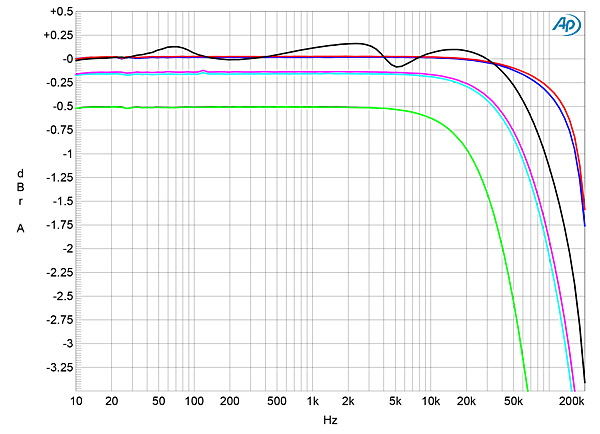
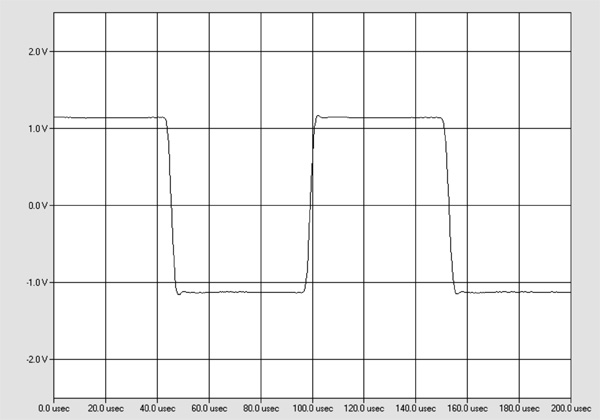
The signal/noise ratios, taken with the inputs shorted to ground and ref. 1W into 8 ohms, were different for balanced and unbalanced operation. The unbalanced, unweighted, wideband ratio was an extremely high 91.5dB in the left channel and 88.3dB in the right. These ratios respectively improved to a superb 102.1 and 101.1dB with an A-weighting filter in circuit. The balanced ratios, however, were all lower, the A-weighted figures being 78.6dB for the left channel, 82.8dB for the right.
Spectral analysis of the low-frequency noise floor with unbalanced drive (fig.3) indicated that there were AC power-supply–related harmonics at 60Hz and both its odd-order harmonics (due to magnetic interference from the massive toroidal power transformer) and its even-order harmonics (due to a non-zero resistance to ground somewhere in the circuit). Other than the spectral component at 60Hz, which was at a still-very-low –94dB (0.002%), these spuriae all lay at or below –107dB (0.0005%), and the random noise-floor components were all extremely low. However, when I repeated the analysis with the balanced inputs, all of the supply-related harmonics rose by around 20dB, which is why the balanced S/N ratios weren't as good as the unbalanced ratios. This is unusual—balanced operation tends to have lower noise, due to the circuit's common-mode noise rejection.
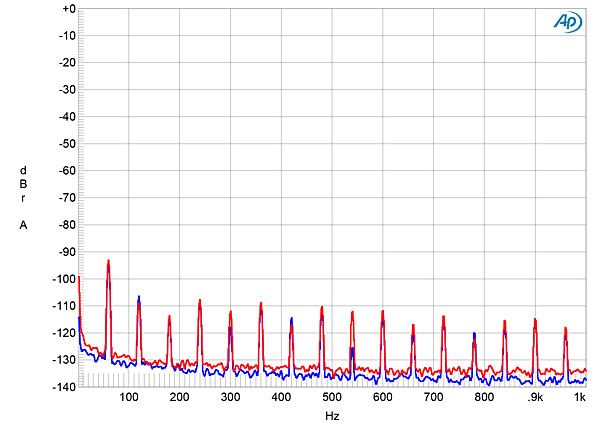
The Monsalvat Amp-60's output is specified as 60Wpc into 8 ohms and 120Wpc into 4 ohms (both equivalent to 17.8dBW), and 180Wpc into 2 ohms (16.5dBW). Our review sample exceeded these specifications into 8 and 4 ohms. With clipping defined as when the THD+noise in the output reaches 1% and with both of the Amp-60's channels driven, I measured clipping powers of 95Wpc into 8 ohms (19.8dBW, fig.4) and 145Wpc into 4 ohms (18.6dBW, fig.5). I don't hold the wall voltage constant during these tests; it measured 119.8V AC at the measured clipping power. However, when I tried to measure the maximum output power into 2 ohms with only the left channel driven, the Amp-60 clipped at just 50W (11.0dBW, fig.6). I repeated the test, this time with only the right channel driven, and got the same result.
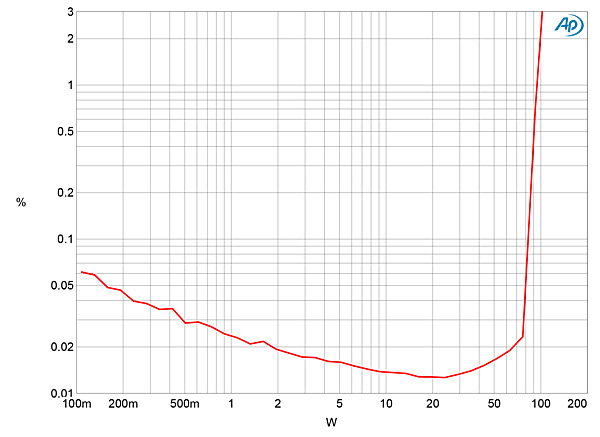
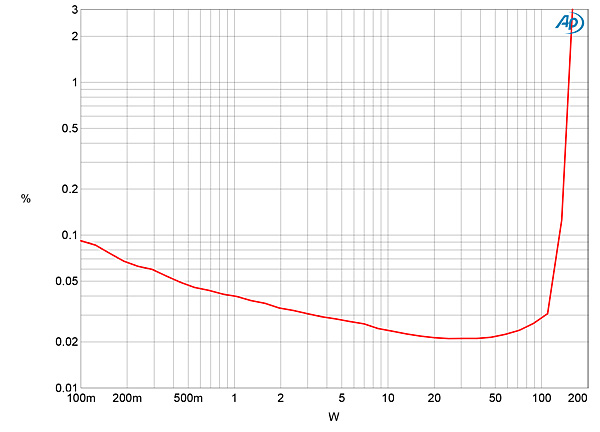
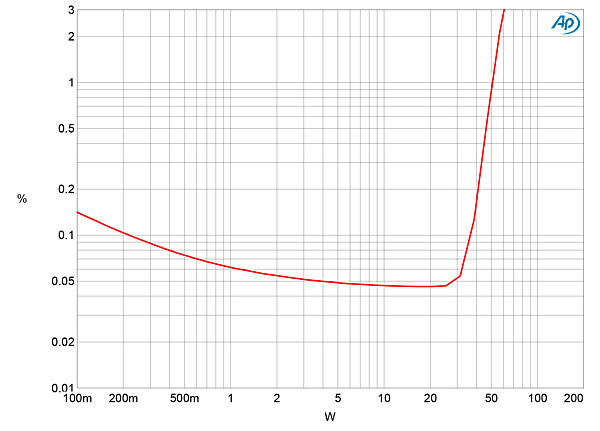
I examined how the Verity amplifier's percentage of THD+N varied with frequency at 10V, which is equivalent to 12.5W into 8 ohms and 25W into 4 ohms. The percentage of THD+N was low in the bass and midrange (fig.7), with the right channel (red and magenta traces) more linear than the left (blue, cyan). While there was the usual rise in the treble due to the decrease in open-loop voltage gain as the frequency increased, this was by only a small amount.
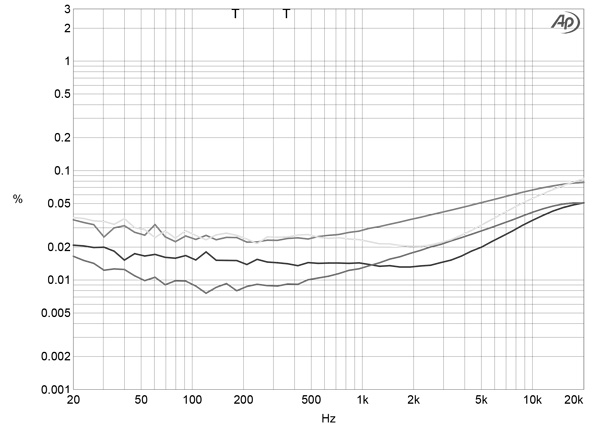
The left channel's THD+N waveform at 30Wpc into 8 ohms (fig.8) indicates that the distortion was low, at 0.013%, and had strong second-harmonic content, though with spuriae also occurring at the zero crossing points. With a low-frequency tone at 50Wpc into 8 ohms, the second harmonic was indeed the highest in level in the left channel, at –78dB (0.012%, fig.9, blue trace). The second harmonic was lower in the right channel, at –87dB (0.004%), and the third harmonic is now the highest in level, at –80dB (0.01%). There are some higher-order harmonics present, as well as supply-related spuriae, but these all lie below –100dB (0.001%). Tested with an equal mix of 19 and 20kHz tones, the Amp-60 produced relatively low levels of intermodulation distortion, even at high powers into low impedances (fig.10). The difference product at 1kHz lay at –77dB in the left channel (0.012%) and at –90dB in the right (0.003%). The higher-order products were all at or below –80dB (0.01%).
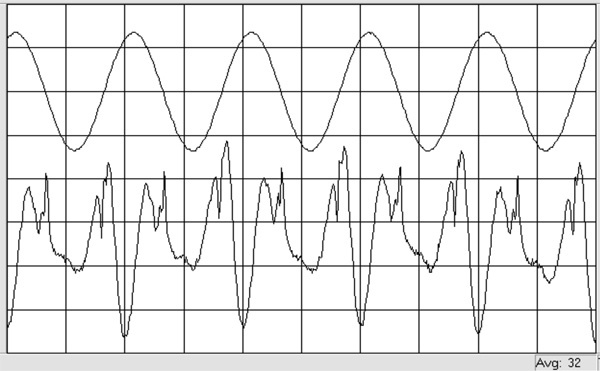
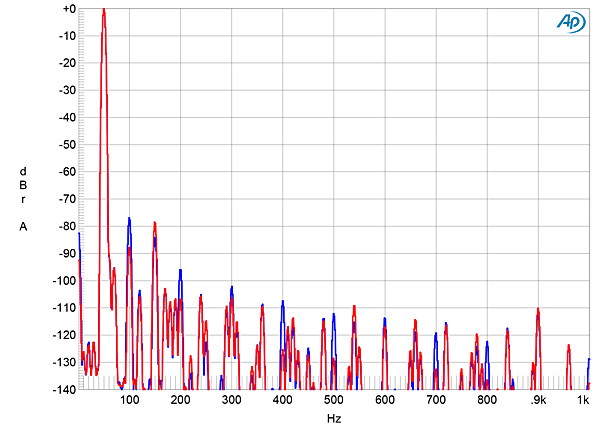
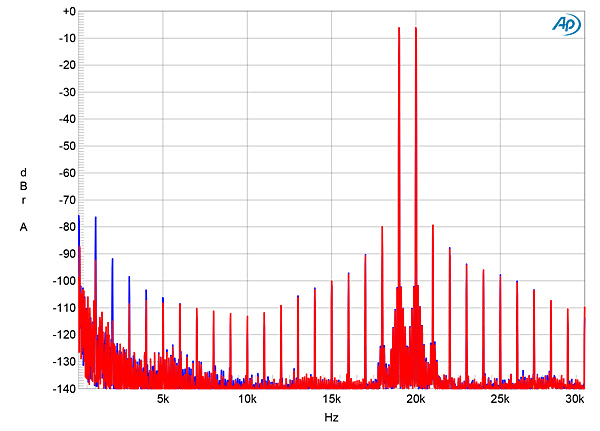
The Verity Monsalvat Amp-60's measured performance is generally respectable. However, I was bothered by the difference in S/N ratios between the balanced and single-ended inputs, and by the shortfall in measured power into 2 ohms.—John Atkinson

I'm asking this because I've read the nearly same Summary about Conrad-Johnson Premier Amps ( that I represented and sold ),
I hear it about nearly every Amplifier being Reviewed.
I found it to be True with the Amplifiers recommended by Quincy Jones : Electrocompaniet.
It kinda leaves me with the conclusion that the Reviewer would arrange to Buy the Reviewed Amp if it was worth owning. Why return it if its a "keeper". I wouldn't . I'd sell the Amp that I have and keep the review sample. Period !
Audiophiles strive to continue building high achiever Music Systems. It certainly is part of the reason for reading this Journal.
The 100 watt Canadian Verity Amp reminds me that the NEW little piece of Schiit Class A Amp is 100 watts. in Mono, $1,600 for two Mono Amps. Is it worthy of a comparable evaluation ? Can it hold it's own ?
Tony in Michigan
ps. Dear Jason,
Please try to keep in mind that American Audiophiles haven't had a pay increase since 1980 and that Schiit is an High Integrety Company that started out the same way Wilson got it's start : Building High Quality Audio Products stuffed full of realizable Values.

May I nominate this amp for the 'worst value for the money' product of the year award? :-) .........

... the $9K McIntosh MC462 - plus a Lexus RX350 with which to haul it home.
https://www.stereophile.com/content/mcintosh-laboratory-mc462-power-amplifier

My wife and I align with you.
Our new motto: buy the Mac and get a free Lexus!

Have any of you HEARD the amp?
NO??
How can you talk of relative value?

... which would you rather buy - a $9K amplifier that is "extraordinarily well-engineered and exceptionally powerful" or the one for $58 that is only "generally respectable"?

and assume without listening or comparing directly. 'Generally respectable' is precisely relative to the system that JVS is using, and you assume you already know what it sounds like or that the qualifer above applies to your system or experience. It probably doesn't- JVS has a nigh-cutting edge system that ours probably doesn't approach.
I know that JA uses that term to describe measurements on amps for many years, but again does that mean the amp sounds worse than your target of a $9k Mac amp? You use it for pure measurement comparisions when the amp could sound so outclassed to 100 people in 100 systems that again, using terms like that to describe either it's measurements or it's SQ is silliness. There are so many other parameters of amp design and execution that can't be measured, or those measurements have litte bearing on how the amp sounds in the real world in front of us. Just ask JA or JVS what they think... or derp... read their review. I don't wonder or question the value of this amp to JVS... I read the review and understand exactly how he values the sound this amp produces (in his system!).
Many would find YOUR assumption that a $9,000 amp from Mac is reasonable, is lunacy. Others would say it is not up to their caliber of what is 'generally respectable'.
It's really not even a question of subjective preference. Their respective performance benchmarks might be so different from yours or mine that any comparision is moot. No, I am not going to waste time comparing the two like a teenager arguing at high school. There are way too many parameters in any stereo system to argue what is best in any hypothetical situation.
The cutting edge of technology in this industry serves the entire industry over time; some succeed, some fail, but all produce movement forward. All are valid, even when you or I don't see a particular outcome serving our ends, or price-point.
If one designer or engineer found a particular, ground-breaking approach to amp design, yet the amp wasn't fully realized on all levels, does not mean that amp was a failure (nor the greatest extant either).
Again, it's all relative, and all really pretty damn valid.

Brother, its a Class B amp with crossover distortion and broken/not working properly XLR inputs lmao

Relative value is EASY. It costs almost $60K and measures pretty poorly for that amount. Therefore it would be relatively easy to find a cheaper amp that sounds and measures better.
What is your job description/title at Verity, if I may ask? Should I re-post in French?

You clearly miss the meaning of 'relative'.
No, it doesn't measure poorly, though lie about it all you want.
Oh, but what amp did you have in mind? Did you actually listen to it or even measure it? (No.)
My title is 'Lying Bitch Crusher' and you don't know French either way...

Show us where the audiofool skeptic touched you here on this doll, ok dear?
I saw the measurements page you dolt....for the price it DOES INDEED measure poorly.
But don't take my word for it, taintface, let's go to the summary of the measurements page:
The Verity Monsalvat Amp-60's measured performance is generally respectable. However, I was bothered by the difference in S/N ratios between the balanced and single-ended inputs, and by the shortfall in measured power into 2 ohms.
I agree with him. Those issues are bothersome at any price point above a few hundred bucks.
Your title is "Lying Bitch" and you got the guys in the badge office to add "Crusher" until your boss made you take it off, tough guy. LMAO

It had a protection circuit in place, jackass/lying bitch/dolt. You are completely wrong. You're bothersome at any price... doll.

You're not very good at this, are you? One trick pony lying little bitch. Fuq u, loser. All you got are lame insults and projection of your own damn jealousy and stupidity whenever you're allowed to use the computer. LMAO your whole family tree lgbtq.

You mad.
HAHHAHAHAHHAHA
Do you subscribe to the magazine or do you just troll?

Monsalvat Amp-60's specifies
60Wpc into 8 ohms
120Wpc into 4 ohms
180Wpc into 2
Your measurements were
95Wpc into 8 ohms
145Wpc into 4 ohms
50Wpc into 2ohms (with only one channel driven)!!!!!!
Typical today, understating the 8ohm to make the 4ohm look better by the manufacturer, but a massive difference into the 2ohm load??
Has the manufacturer said anything on this??
Cheers George

The Manufacturer's Comment addresses this issue.

Where are they, there is no post review "Manufactures Comments" tab????
Cheers George


... the (lack of) quality control procedures in place at Verity Audio.
Is there any plan to (re)test an "adjusted" sample to confirm that it can meet the manufacturer's published claims?


Sounds like they're padding the profit margin at the expense of a quality control program. Par for the course with Western capitalism ca. 2019, I guess. Only thing that matters is this quarter's profits, not long term viability or a stable/just socio-economic system. Sigh...I mean really....sending off an amp for a high-profile test in the highest profile audio magazine on the planet, and it having a "glitch"? LOL!!!

They put a protection circuit place... Read first. Then act like a know it all.. LOL!!

LMAO....you ever been laid? You do know you can pay somebody right? No judgment here....but you clearly have major issues.


This amp is a very good example why, measurements are very important when making buying decisions :-) ..........

Some amps aren't designed to double their ratings into 2 ohms.

True ..... The distortion levels are also high ....... 2nd and 3rd harmonic distortions ....... Look at the figures 9 and 10 in the measurements section ........ Compare this with the figures 12 and 13 of McIntosh 462 amp measurements :-) ........

In other words ........ JA1 was very polite, in a true British gentleman's way, when he said, "respectable measured performance" :-) ...........

Twice the manufacturer mentioned that the amp was designed with much higher impedance specs in mind... your statement implies that JA1 is lying or covering for the mfg. He, rather, respects the measured performance.
I find it disingenuous that all of the 'measurements-only' posters all feel the amp is a failure, when JVS found the amp to be 1 of the top amps he has ever had in his listening room.
Hilarious that none has talked about how the amp sounds, other than the 'bass-lightness' comments one poster mentioned.
Do any of the other posters actually listen to music, or rather just test equipment for their enjoyment and validation?

I'm not talking about the sound quality ........ I'm talking about price/performance ratio ........
Here are some examples of the amplifiers which cost less than this amplifier, which are Class-A rated by Stereophile ......... You may search for their Stereophile reviews :-) .........
Pass Labs .......
Mark Levinson ........
Dan D'Agostino ........
Audio Research .........
Bryston .........
PS Audio BHK signature .........
PS Audio Stellar ..........
Benchmark .........
McIntosh Labs ........
Ayre Acoustics ........
Bel Canto ..........
I did not mention all of them ......... You can look at all the names in the Stereophile Class-A amplifier listing :-) ..........

I will guarantee you this amp will make this Class A list too...
Huh. Sound quality is a DIRECT concern to value.. How can it NOT be? One listens to music through this... oh that's right- you don't.
You wouldn't know price-performance ratio here anyways.. you haven't heard the amp. You are again making assumptions about measurements to performance... as everyone else does (wrongly).

You're claiming you don't have any relationship to this product or any emotional attachment, but you say shit like this?
I will guarantee you this amp will make this Class A list too...
Yeah right. DCV LOL

You're claiming you don't have any relationship to this product or any emotional attachment, but you say sh*t like this?
I will guarantee you this amp will make this Class A list too...
Yeah right. DCV LOL

Emotional relationship to your complete and utter misanthropic bullshit.
I read the review... (AND the mfg. comments) hence my claim. Youd didn't- Hence your bullshit. What a child.
And you will be WRONG once again, come October... CLASS A.
We BOTH know that...
HAHAHAHHAHAHAHAHAHAH

This Verity amp was most likely designed to sound like a tube amp, with suboptimal SNR and 2nd and 3rd harmonic distortions :-) .........

... relatively higher levels of distortion overlaid on top of their music.
What's hilarious is that the reviewer uses hi-res (let alone Redbook 16-bit) digital recordings for equipment evaluation purposes when the amp in question struggles to reach even the level of 14-bit resolution.

Dear editor ....... Please delete the above comment :-) ........

Take a look at Stereophile D'Agostino Momentum and Progression amps measurements :-) ..........

You may also want to take a look at Stereophile darTZeel amps measurements :-) ...........

If you want to know how the 3rd harmonic looks like, look at the Stereophile PS Audio Stellar mono-block measurements :-) ...........

Well, look at the bright side ....... all the above are better than Border Patrol measurements :-) ........

.... of 14-bit resolution." quoted Ortofan.
How come "the amp in question STRUGGLES to reach even 14-bit resolution'?????????
Whatever bits the music is mastered, what comes out of the CD player into the amp is only at audio frequency spectrum. So what "struggles"???
Jack L.

BTW ...... That noise provides 'continuousness' to the music :-) ..........

Do you work for Verity, Francois Glotz, is it?
Why are you such a whiny high-maintenance crybaby for this one particular manufacturer?

The only one...
Whiny little hater.
I coulon't care less about the amp or the company. I care about douchebags that spread FAKE NEWS. READ- YOU.
Did you have ANYTHING of SUBSTANCE regarding AUDIO that you want to say? OTHER THAN...NOTHING?!?
Your racist comments about the French tell more about you... than about me.

...... The distortion levels are also high ....... 2nd harmonic distortion .." quoted Bogolu Haranath.
What does harmonic distortion figures high or low to do with how it SOUNDS???
A SET tube power amplifier measured 5% total harmonic distortion can sound much better than a sold state power amp measured 0.00005% total harmonic distortion !
Listening, not measurement, is believing
Jack L
Canada

... is comparable to a digital recording with a resolution of only 12 bits. Would you be willing to buy such "lo-res" recordings?
If not, then why use an amplifier whose distortion obscures any information below/beyond the level of 12 bits?

Then why does the manufacturer state that it can do 180w@2ohms in their specs?? When it clearly can't in the JA tests it only got to 50w?
Cheers George

is this far away:
Verity Audio
1005, Ave Saint-Jean-Baptiste, bureau 150
Québec (Québec)
G2E 5L1
Canada
Téléphone: 418-682-9940
Fax: 418-682-8644
Email: info@verityaudio.com


In fat it was designed to TRIPLE its rating into 2 ohms. All you need to do is download their brochure, moron:
Power output: 60 watts per channel @ 8 ohms
120 watts per channel @ 4 ohms
180watts per channel @ 2 ohms
http://www.verityaudio.com/monsalvat/images/brochures/amp-60.pdf
Again, I can start posting in French if you need me to....just say the word, Lyin'bitch.

Hee hee...
Keep it up...
Maybe one day you'll get the NEW MEASUREMENTS for a Christmas Gift???
Another Bitch Crushed... THOMAS!
HAHAHHAHAHAHAHAAHHAA...

Hi
Sorry, what makes me to like purchasing any audio equipment is always its SOUND quality. Measurement serves me only as a reference, e.g. output powers.
Let me take an example out of a master degree thesis on correlation between sound quality vs its measurement of an audio amplifier some years back:-
" A SET tube power amplifier measured 5% total harmonic distortion sounded so much better than a solid state power amplifier which measured 0.00005% total harmonic distortion."
So which of the above said amplifier would you like to purchase given price being out of the equation.
Listening, not measurement, is believing.
Jack L.
Canada

Easy answer ....... I would buy PS Audio Stellar mono-blocks, $3,000/pair ....... Measure well and sound good ....... Stereophile Class-A :-) ..........

The SET Tube Power Amp also sounded 50% better than reality in a quintuple bypass test.

"Jim Austin: According to the manufacturer, JA's 2ohm measurement is correct but is a result of a glitch in their protection circuit, which has now been addressed."
I must address this type of post review comment, that we see all too often when thing don't go to (manufacturers) plan.
I ask??? wouldn't any manufacturer, submitting a product for review by Stereophile to be read worldwide!! make sure that product is 100% fit, (or even better) for the review/bench test? As it is almost a do or die for them to be able to launch this product.
I couldn't imagine anyone sending an old workhorse they didn't know was 100% fit??
Cheers George

If you read through Stereophile's archives, you'll find a surprising number of components sent in for review that were in some way broken including a few that caught on fire, etc.
This, to me, is a pretty mild case. There are many details to be sorted. They overlooked one. I'm not saying it's OK--people can judge it however they wish--but I think it's more likely to find such errors in expensive products because they're produced at lower volumes. Less opportunity for "beta" testing (as it were) and a more "boutique" approach to production (as opposed to a 'banish-the-bugs' assembly line). But whatever the reason, it's not uncommon.
Jim Austin, Editor
Stereophile

If you read through Stereophile's archives, you'll find a surprising number of components sent in for review that were in some way broken including a few that caught on fire, etc.
From 1989: www.stereophile.com/content/when-things-go-wrongit-hurts-me-too.
John Atkinson
Technical Editor, Stereophile


Stereophile, June 13, 2010:
https://www.stereophile.com/content/have-you-ever-had-anything-smoke-or-catch-fire


They just report ...... They don't decide ........ The readers have to decide :-) .........

"I'm inclined to believe that my experience of its lighter-than-ideal bass accurately reflects the amp's character."
Common, I'm sure the reviewer knows better, this is more than the "character" description of the amp, it's the amps inability to drive current into the Wilsons Alexia's 2ohm bass load, even lower if the EPDR is taken into account.
PS: I'm sure that "lighter bass character" would disappear with speaker that had a bass load much easier than the Alexia's have.
Cheers George

As Verity Audio is from my neck of the woods and my old stomping ground. Their speakers are some of the finest I have ever heard, coupled with Acoustic Research electronics and their CD9, I was floored as to how good they sounded when I heard them. So, I am hoping this is a great amp. I will add one caveat, this is their 1.0 version and as such I do expect there will be upgrades as it moves along. As in software and all IT related things you are taught to never buy 1.0 but wait for 1.2 if not more. Will this be a winner? The market will answer that question, but if this amp matches the high quality their speakers are then it sure will be a winner. Will listen when I head back up to Quebec for a visit. Till then any negative critiques are premature.

If there were no glitch and the amp actually performed as claimed, it would have to be an 80,000 dollar product.
Verity is just being sensible with your hard earned money.
I’m glad we had this talk.

Is free (hand) delivery included in that $80,000 price tag? :-) ..........
It may be too heavy for Santa to carry it down the chimney :-) ...........

5 stages of grief .......... Denial, anger, bargaining, depression and acceptance :-) .........